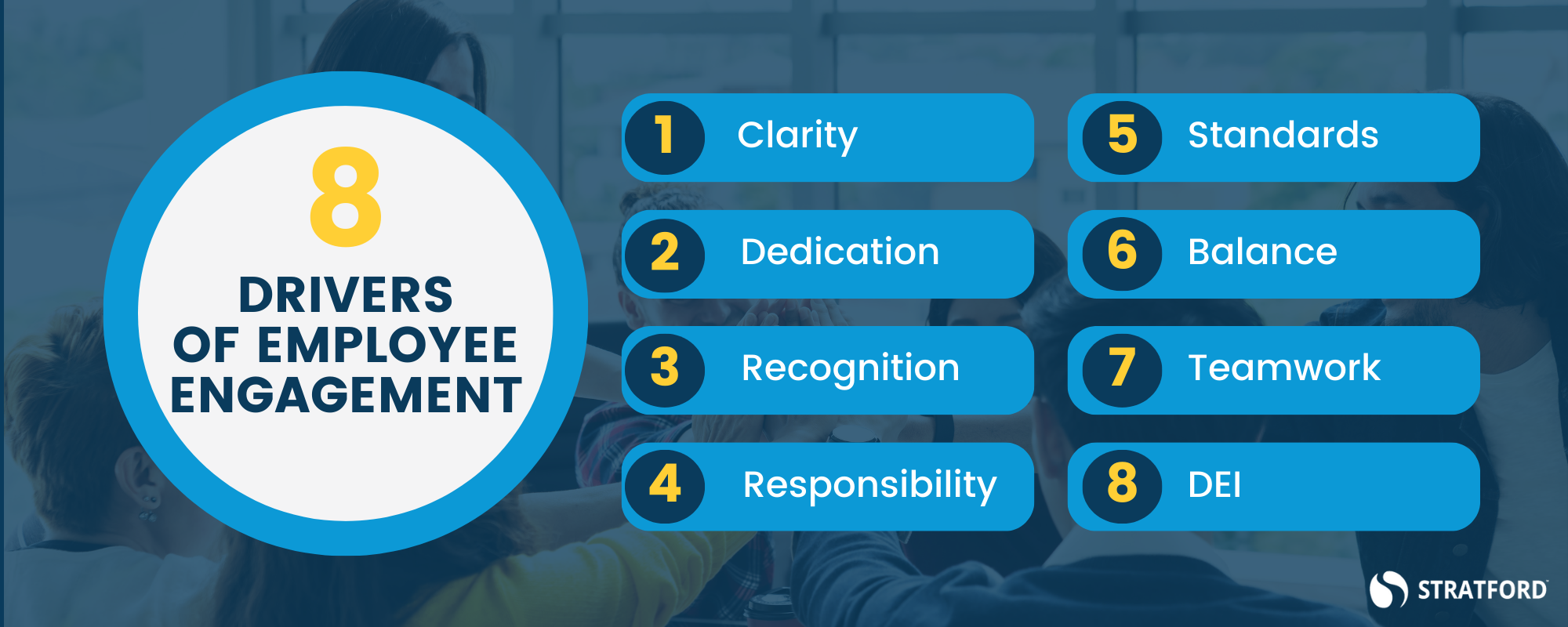A recent Gallup report underscores the importance of employee engagement, linking it to a positive climate fostered by meaningful relationships with managers. This engagement drives significant improvements in productivity, profitability, and reduces absenteeism and attrition. The report highlights the desire for employees to find purpose and recognition in their work.
To enhance employee engagement, we're sharing the eight key drivers that you should be focusing on: clarity in role and organizational goals, dedication to accommodating diverse work expectations, recognition beyond monetary rewards, responsibility and empowerment, clear performance standards, work-life balance, teamwork and trust in leadership, and a strong commitment to diversity, equity, and inclusion (DEI). Starting with employee engagement can be as simple as organizations listening to their employees' opinions.
What causes employees to ‘connect’ with their organization? A recent Gallup report ties engagement to a climate that allows employees to be motivated and focused with the biggest success factor being a relationship with their manager who is invested in their work. The report goes on to say “People want purpose and meaning from their work. They want to be known for what they are good at.”
The payoffs are numerous, that same Gallup report links employee engagement with improved outcomes in reducing absenteeism and increasing profitability and productivity as well as lower attrition.
In my experience, HR departments and managers can improve employee engagement by focusing on six key drivers:

Driver #1 | Clarity
Employees evaluate the significance of their work based on their perceived proximity to the mission of the organization. Managers can increase engagement by communicating the link between specific job responsibilities and organizational goals.
In today's increasingly remote and hybrid work environments, this clarity becomes even more crucial as employees seek transparency and understanding of their roles from afar.
Driver #2 | Dedication
With today’s diverse, multi-generational, mobile workforce, organizations face a wide range of employee expectations about the location and time of work. Organizations that can offer roles and projects adapted to individual employees are most successful in attracting and fully engaging in them in their work.
Driver #3 | Recognition
Unsurprisingly, money alone is not the solution to employee engagement. while fair and equitable remuneration is a contributor to overall engagement, the impact is far less than the sense of significance, and accomplishment that employees have in their work and the recognition that comes from a job well done. Quantum Workplace research indicates that the number of employees seeking more recognition from their manager is over half at 52.5%
Deploying creative programs that allow team members to reward each other for doing amazing work can both help engagement and assist in measuring individual employee contribution. Opportunities for public recognition from management should be readily available.
Driver #4 | Responsibility
Open positions within organizations are often quickly filled with top talent. This plus the substantial workloads and flat organization structures increasingly common in today’s workplace can lead to a perceived lack of skill development and career advancement opportunities for staff.
Managers can maintain engagement by encouraging empowerment and responsibility within their employees’ roles.
Driver #5 | Standards
Today’s workforce insists that performance expectations be well defined and evaluated fairly. Developing a clear set of indicators that track and measure important elements of individual and team performance is an important driver of engagement.
Driver #6 | Balance
The focus on employee mental health has grown significantly over the past 5 years, with organizations prioritizing the incorporation of wellness programs and initiatives to support work-life balance.
Ensuring employees feel valued and have access to mental health resources is crucial for engagement.
Driver #7 | Teamwork
The importance of work relationships and trust in senior leadership remains a top driver of employee engagement. In an increasingly digital workplace, creating opportunities for virtual team-building and transparent communication is key to fostering these relationships.
Leaders can accelerate trust by focusing on people and identifying their needs, using active listening skills, and openly sharing information about the organization and themselves.
Driver #8 | Commitment to Diversity, Equity, and Inclusion (DEI)
Effective DEI programs are now recognized as foundational to engaging and connecting with employees. A diverse and inclusive workplace fosters a sense of belonging and respect, driving engagement and productivity.
Getting Started with Employee Engagement
Sounds like a lot of work? According to a Psychometrics engagement study “Control, Opportunity and Leadership”, 70% of respondents just asked their organization to listen to their employees’ opinions.
So listen-up! Contact our HR team today to get started!
FROM THE ARCHIVES: This blog post was originally published in 2013 as "Six Drivers of Employee Engagement" and drew supporting information from a Harris/Decima survey. It has been republished with new content and updated supporting materials.
About the Author:
 |
Dean brings more than 20 years of experience and a deep expertise in leadership development, organizational development and design, project management, process mapping, and best-practice benchmarking activities. With an extensive background in organization development and effectiveness, performance consulting and process improvement, Dean compliments his HR background with strong process management and competency-based project experience. He is a member of Stratford’s Leadership team, responsible for its Leadership Development practice area. Dean has held HR Executive roles in high technology and financial services firms, responsible for design, implementation, and oversight of organizational development, effectiveness and human resource programs at both the local and global levels. |

